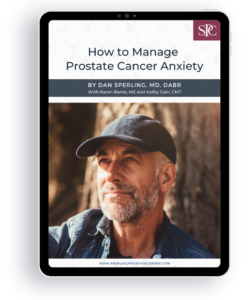Here’s the back story: there is a British clinician/researcher, Hashim Ahmed, whose published articles I respect. His publications often include Mark Emberton, another esteemed British urologist, so when both names turn up in the same group of authors on a published paper, it grabs my attention.
This is the case with a 2020 multicenter study titled “Evaluating the Trade-Offs Men with Localized Prostate Cancer Make between the Risks and Benefits of Treatments: The COMPARE Study.”[i] It’s about time someone put the expression “trade-off” in the limelight.
First, I have to say I’m amazed that in the year 2020 it’s even still an issue. We live in an age when Active Surveillance (AS) is an ever-increasing choice for men diagnosed with low-risk prostate cancer (PCa); for these men, who can safely hold off on treatment, the odds are good that they are preserving their expected lifespan as well as their urinary and sexual function. No trade-off there!
We also live in an age when focal treatment for low-risk and even favorable intermediate-risk PCa is an option. With a treatment like our Focal Laser Ablation, there’s low risk of urinary and sexual side effects, and a very good chance that PCa tumor has been completely destroyed. Again, no trade-off!
But let’s face it, either robotic-assisted radical prostatectomy or some form of radiation is still presented to patients as a first line of treatment. This means that when a newly diagnosed patient is considering a whole gland (radical) treatment, he faces a cost-benefits analysis he never imagined. With radical treatments, men must weigh their potential long-term survival vs. their risk of diminished quality of life.
Think about it. What would be your preference if these were your choices?
- You can live longer but you’ll be using pads or diapers?
- You can live longer but you’ll need pills, mechanical assistance, injections or surgery to have erections?
- You can keep your continence and sexual function but you might die some years sooner than you otherwise might have because you left your disease untreated for a while?
The aim of the COMPARE study (COMparing treatment options for ProstAte cancer) was to evaluate the trade-offs between AS and definitive treatment, and quantify patient preferences. I found this demographic approach fascinating, because gathering statistics is different than speaking one-on-one with a patient to learn his wishes and preferences. The study involved over 600 patients from 34 urology departments. Within a week of being diagnosed—but before they made a treatment decision—they profiled their preferred treatment profile based on
- Treatment type (AS, focal treatment, radical treatment)
- Return to normal activities
- Erectile function
- Urinary function
- Not needing more cancer treatment
- 10 to 15-year cancer specific survival
Study findings
According to the authors’ analysis, those with low-to-intermediate PCa were willing to trade 6.99% absolute decrease in survival to go on AS rather than have definitive treatment. Furthermore, “…they were willing to trade 0.75%, 0.46% and 0.19% absolute decrease in survival for a 1-month reduction in time to return to normal activities and 1% absolute improvements in urinary and sexual function…”[ii]
As for those with high-risk PCa, they too were willing to trade decrease in survival—though to lesser extent as their lower-risk counterparts–for a month less time to return to normal activities and 1% absolute improvements in urinary and sexual function.
Overall, the authors wrote, “Patients with low-intermediate risk prostate cancer preferred active surveillance to definitive therapy. Patients of all risk levels were willing to trade cancer specific survival for improved quality of life.”
Focal therapy is the happy medium
I believe there doesn’t need to be a trade-off. Thanks to multiparametric MRI and real-time MRI-guided targeted biopsy, we offer patients the best available diagnostic methods in terms of visual, microscopic and genomic information. Of course, not every patient is a candidate for AS or focal therapy, but for those who are, they do not have to sacrifice longevity for quality of life, or vice versa. They can immediately have the best of both worlds, as well as superior follow-up and monitoring for early detection of suspicious activity.
If you are newly diagnosed with PCa, don’t let yourself be put in the position of having to make and either/or decision that amounts to a trade-off. Contact the Sperling Prostate Center to find out if a happy medium is the best choice for you.
Download Our Free Ebook: “How to Manage Prostate Cancer Anxiety”

Don’t let anxiety over prostate cancer run you. Instead, learn how you can take charge and empower yourself to manage stress and boost positive treatment outcomes with our “first aid kit” of practical tips and tools.
NOTE: This content is solely for purposes of information and does not substitute for diagnostic or medical advice. Talk to your doctor if you are experiencing pelvic pain, or have any other health concerns or questions of a personal medical nature.
References
[i] Watson V, McCartan N, Krucian N, Abu V, Idenwilo D, Emberton M, Ahmed H. Evaluating the Trade-Offs Men with Localized Prostate Cancer Make between the Risks and Benefits of Treatments: The COMPARE Study. J Urol. 2020 Aug;204(2):273-280.
[ii] Ibid.


